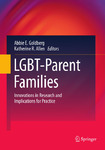LGBT-Parent Families
Abstract
In 2003, I began teaching an undergraduate course titled “Sexual Diversity in
Society” in what proved to be a turning point year for North American struggles
for LGBT family rights. Gay rights plaintiffs in the USA and Canada
scored a series of landmark court victories that year. State and provincial
Supreme Courts in Massachusetts, Ontario, and British Columbia became the
fi rst in this hemisphere to judge bans on same-sex marriage unconstitutional,
and in its historic ruling in the Lawrence v. Texas case, the USA Supreme
Court reversed itself by overturning antisodomy laws. A scathing dissent by
Justice Scalia correctly forecast the implications of this decision for the ultimate
legalization of same-sex marriage.
I always begin my courses on sexual diversity by conducting an anonymous,
informal survey about my students’ sexual experiences, beliefs, attitudes,
identities, and aspirations. Over the course of the past decade, I’ve
noticed two intriguing, super fi cially contradictory, trends in the data produced
by this decidedly unrepresentative sampling method. Unexpectedly, the number
of women who label themselves lesbian has declined sharply, and the
ranks of students claiming gay, or even straight, identities have been ebbing
as well. Instead, students with nonconforming sexual or gender inclinations
and practices, and women especially, have become more apt to describe
themselves as “questioning, curious, undecided, or queer.” Some refuse to
de fi ne their sexuality at all.
Collections
- School of Humanities [47]

